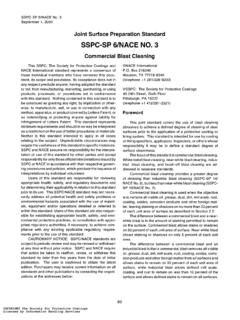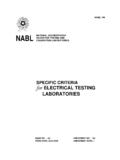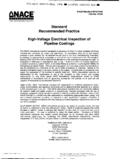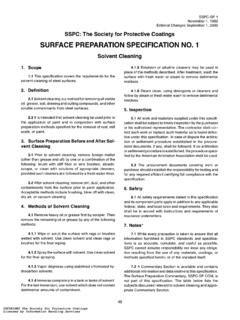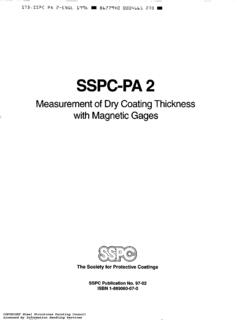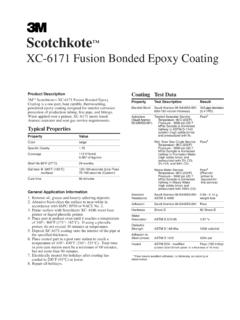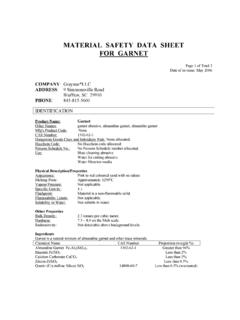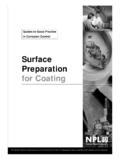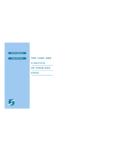Transcription of Recommended Practi - Reli Sleeve
1 StandardRecommended PracticeField measurement of Surface Profile of AbrasiveBlast-Cleaned Steel Surfaces Using a Replica TapeThis NACE International standard represents a consensus of those individual members who havereviewed this document, its scope, and provisions. Its acceptance does not in any respectpreclude anyone, whether he has adopted the standard or not, from manufacturing, marketing,purchasing, or using products, processes, or procedures not in conformance with this contained in this NACE International standard is to be construed as granting any right, byimplication or otherwise, to manufacture, sell, or use in connection with any method, apparatus, orproduct covered by Letters Patent, or as indemnifying or protecting anyone against liability forinfringement of Letters Patent.
2 This standard represents minimum requirements and should in noway be interpreted as a restriction on the use of better procedures or materials. Neither is thisstandard intended to apply in all cases relating to the subject. Unpredictable circumstances maynegate the usefulness of this standard in specific instances. NACE International assumes noresponsibility for the interpretation or use of this standard by other parties and acceptsresponsibility for only those official NACE International interpretations issued by NACEI nternational in accordance with its governing procedures and policies which preclude theissuance of interpretations by individual of this NACE International standard are responsible for reviewing appropriate health, safety,environmental, and regulatory documents and for determining their applicability in relation to thisstandard prior to its use.
3 This NACE International standard may not necessarily address allpotential health and safety problems or environmental hazards associated with the use ofmaterials, equipment, and/or operations detailed or referred to within this standard. Users of thisNACE International standard are also responsible for establishing appropriate health, safety, andenvironmental protection practices , in consultation with appropriate regulatory authorities ifnecessary, to achieve compliance with any existing applicable regulatory requirements prior to theuse of this NOTICE: NACE International standards are subject to periodic review, and may berevised or withdrawn at any time without prior notice. NACE International requires that action betaken to reaffirm, revise, or withdraw this standard no later than five years from the date of initialpublication.
4 The user is cautioned to obtain the latest edition. Purchasers of NACE Internationalstandards may receive current information on all standards and other NACE Internationalpublications by contacting the NACE International Membership Services Department, 1440 SouthCreek Drive, Houston, Texas 77084-4906 (telephone +1 [281] 228-6200).Reaffirmed 2002-09-10 Reaffirmed September 1995 Reaffirmed March 1991 Approved 1987 NACE International1440 South Creek DriveHouston, TX 77084-4906+1 281/228-6200 ISBN 1-57590-151-X 2002, NACE InternationalNACE Standard RP0287-2002 Item No. 21035 COPYRIGHT 2002; NACE International Document provided by IHS Licensee=Aramco HQ/9980755100, User=, 11/11/200205:38:47 MST Questions or comments about this message: please call the DocumentPolicy Management Group at | | ||| | | || || ||| |||| ||| ||||| | | || | |||---RP0287-2002 NACE Internationali_____ForewordPrior to the application of protective coatings to steel surfaces, the surfaces are frequently cleanedby abrasive impact.
5 Such abrasive cleaning roughens the steel surface, providing a surfaceprofile. The resulting degree of surface roughness is affected by many variables, including thetype, size, and shape of the abrasive used, velocity of impact, techniques and instruments are currently used to measure the surface texture or surfaceprofile; however, those that provide a high degree of precision are suitable only for laboratory a surface profile range is frequently specified and the Recommended surface profile isdifferent for various types of coatings, a means of surface profile measurement at the work site purpose of this standard Recommended practice is to provide a procedure to measure thesurface profile of abrasive blast cleaned steel. The measurement technique utilizes a tape thatreplicates the surface profile.
6 The thickness of the tape (with the profile replicate) is then meas-ured with a dial micrometer to determine the surface profile. Other common methods of measuringsurface profile are not discussed. The procedure described in this standard is limited to themeasurement of surface profile with a profile defined as being between 38 and 114 m ( mils) prepared to a white metal,1near-white metal,2or commercial3blast-cleaned determination of surface profile depends on its definition. This procedure determines surfaceprofile only as it is defined in this standard (see Paragraph ). If surface profile is defineddifferently, the procedures outlined in this standard may not provide accurate results. Individualmeasurements of the surface profile of an abrasive blast -cleaned metal surface vary significantlyfrom area to area over a given A presents the results of a round-robin series of measurements by several individuals,and illustrates the degree of accuracy of the procedure described in this standard.
7 Appendix Bstatistically summarizes the data shown graphically in Appendix A. Panels used in the tests shownin Appendix A were hot-rolled and nonrusted. The extraneous profile of severely rusted surfacesreduces the accuracy of the procedure. Measurements are taken on relatively flat areas where thesurface appears to be continuous and standard is intended for use by persons, usually in an inspection capacity, who have arequirement to measure the surface profile of abrasive blast -cleaned steel prior to the applicationof a protective standard was originally prepared in 1987 by NACE International Task Group T-6G-19, a com-ponent of Unit Committee T-6G on Surface Preparation for Protective Coatings. The standard wasreaffirmed in 1991 and 1995 by Unit Committee T-6G, and in 2002 by Specific Technology Group(STG) 04 on Protective Coatings and Linings Surface Preparation.
8 This standard is issued byNACE International under the auspices of STG NACE standards, the termsshall,must,should, andmayare used in accordance with thedefinitions of these terms in theNACE Publications Style Manual, 4th ed., Paragraph used to state mandatory requirements. The termshouldis used to state somethingconsidered good and is Recommended but is not mandatory. The termmayis used to statesomething considered 2002; NACE International Document provided by IHS Licensee=Aramco HQ/9980755100, User=, 11/11/200205:38:47 MST Questions or comments about this message: please call the DocumentPolicy Management Group at | | ||| | | || || ||| |||| ||| ||||| | | || | |||---RP0287-2002iiNACE International_____NACE InternationalStandardRecommended PracticeField measurement of Surface Profile of abrasive blast -Cleaned Steel Surfaces Using a Replica TapeContents1.
9 12. 13. Equipment ..14. 2 Appendix A: Results of NACE Task Group T-6G-19 Round-Robin Tests .. 2 Appendix B: Statistical 5_____COPYRIGHT 2002; NACE International Document provided by IHS Licensee=Aramco HQ/9980755100, User=, 11/11/200205:38:47 MST Questions or comments about this message: please call the DocumentPolicy Management Group at | | ||| | | || || ||| |||| ||| ||||| | | || | |||---RP0287-2002 NACE International1_____Section 1: This standard describes a procedure for on-site meas-urement of the surface profile of abrasive blast -cleanedsteel surfaces that have a surface profile, as defined inSection 2, between 38 and 114 m ( and mils). Theprocedure has been demonstrated to correlate well with themeasurements obtained by the defined laboratory pro-cedure on nonrusted panels prepared to NACE (1)-SP 5,1 NACE No.
10 2/SSPC-SP 10,2or NACE are given regarding the imple-mentation and use of this 2: DefinitionsSurface Profile:For the purposes of this standard, surfaceprofile is defined as that value obtained when the profile of asurface is measured using an optical microscope asdescribed in NACE Publication laboratoryprocedure described in 6G176 entails averaging a stat-istically significant number of readings (20 to 30) using anoptical microscope, magnification of 250 to 280X, with afield of to mm ( to in.) diameter, andrecording the distance measured from the top of the highestpeak to the bottom of the lowest valley in the field of 3: Replica The replica tape consists of a compressiblefoam containing microscopic bubbles attached to apolyester film 50 m (2 mils) thick.
